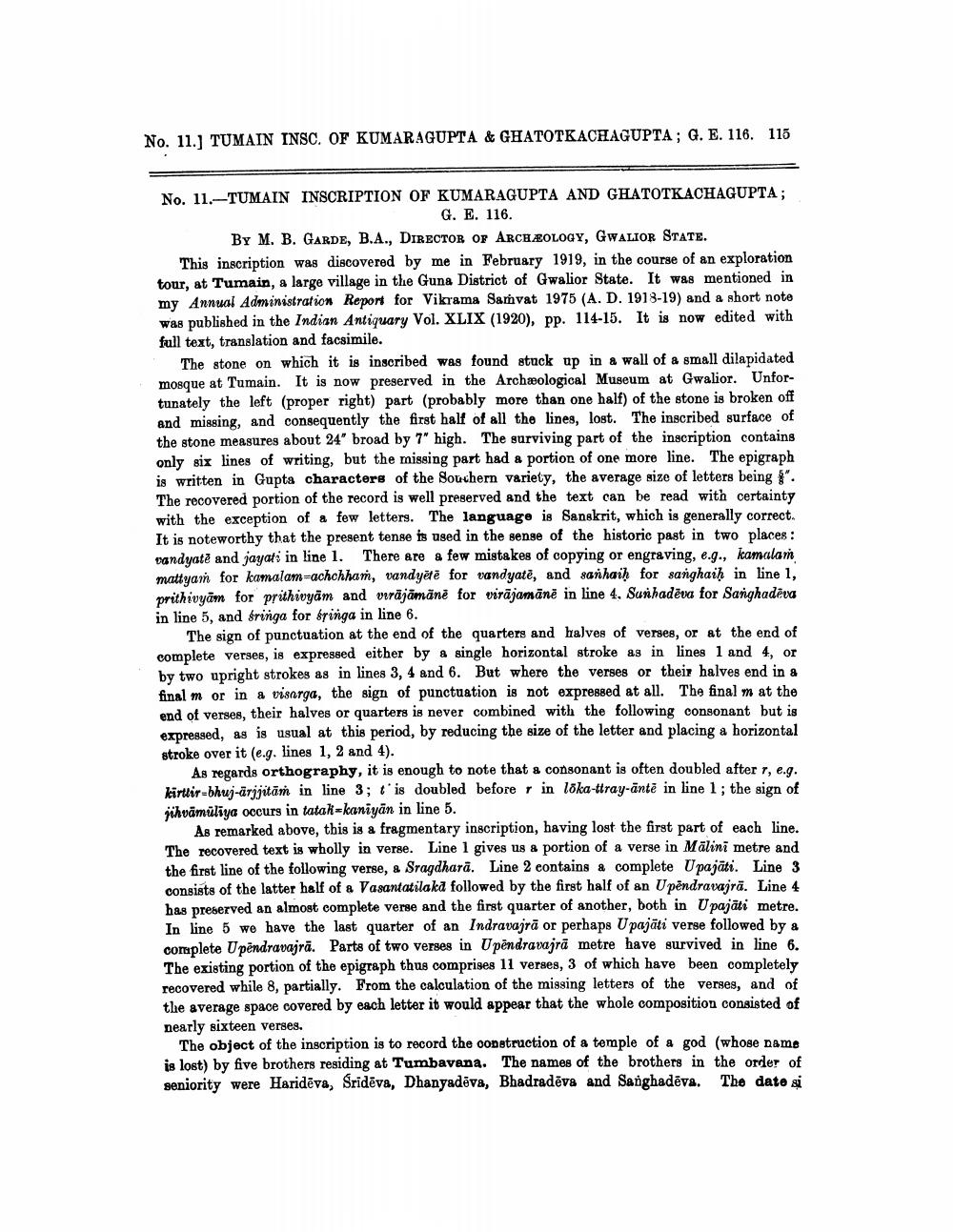________________
No. 11.) TUMAIN INSC. OF KUMARAGUPTA & GHATOTKACHAGUPTA; G. E. 116. 115
No. 11.-TUMAIN INSCRIPTION OF KUMARAGUPTA AND GHATOTKACHAGUPTA;
G. E. 116. BY M. B. GARDE, B.A., DIRECTOR OF ARCHÆOLOGY, GWALIOR STATE. This inscription was discovered by me in February 1919, in the course of an exploration tour, at Tumain, a large village in the Guna District of Gwalior State. It was mentioned in my Annual Administration Report for Vikrama Samvat 1975 (A. D. 1918-19) and a short note was published in the Indian Antiquary Vol. XLIX (1920), pp. 114-15. It is now edited with full text, translation and facsimile.
The stone on which it is inscribed was found stuck up in a wall of a small dilapidated mosque at Tumain. It is now preserved in the Archæological Museum at Gwalior. Unfortunately the left (proper right) part (probably more than one half) of the stone is broken off and missing, and consequently the first half of all the lines, lost. The inscribed surface of the stone measures about 24' broad by 7" high. The surviving part of the inscription contains only six lines of writing, but the missing part had a portion of one more line. The epigraph is written in Gupta characters of the Souchern variety, the average size of letters being '. The recovered portion of the record is well preserved and the text can be read with certainty with the exception of a few letters. The language is Sanskrit, which is generally correct. It is noteworthy that the present tense is used in the sense of the historic past in two places: vandyate and jayati in line 1. There are a few mistakes of copying or engraving, e.g., kamalar mattyan for kamalam-achchham, vandyetė for vandyatē, and sarhaih for sanghaih in line 1, prithivyām for prithivyām and veräjāmānė for virājamānē in line 4. Sunhadēva for Sanghadēva in line 5, and bringa for bringa in line 6.
The sign of punctuation at the end of the quarters and halves of verses, or at the end of complete verses, is expressed either by a single horizontal stroke as in lines 1 and 4, or by two upright strokes as in lines 3, 4 and 6. But where the verses or their halves end in a final m or in a visarga, the sign of punctuation is not expressed at all. The final m at the end of verses, their halves or quarters is never combined with the following consonant but is expressed, as is usual at this period, by reducing the size of the letter and placing a horizontal stroke over it (e.g. lines 1, 2 and 4).
As regards orthography, it is enough to note that a consonant is often doubled after 1, e.g. kirttir-bhuj-arijitāṁ in line 3; t' is doubled before r in loka-ttray-ante in line 1; the sign of jihvamüliya occurs in tatak-kaniyan in line 5.
As remarked above, this is a fragmentary inscription, having lost the first part of each line. The recovered text is wholly in verse. Line 1 gives us a portion of a verse in Mălini metre and the first line of the following verse, & Sragdharā. Line 2 contains a complete Upajäti. Line 3 consists of the latter half of a Vasantatilakd followed by the first half of an Upendravairā. Line 4 has preserved an almost complete verse and the first quarter of another, both in Upajäti metre. In line 5 we have the last quarter of an Indravajrā or perhaps Upajāti verse followed by a complete Upendravajrā. Parts of two verses in Upendravajrā metre have survived in line 6. The existing portion of the epigraph thus comprises 11 verses, 3 of which have been completely recovered while 8, partially. From the calculation of the missing letters of the verses, and of the average space covered by each letter it would appear that the whole composition consisted of nearly sixteen verses.
The object of the inscription is to record the construction of a temple of a god (whose name is lost) by five brothers residing at Tumbayana. The names of the brothers in the order of seniority were Haridēva, Sridēva, Dhanyadēva, Bhadradēva and Sanghadēva. The date si




